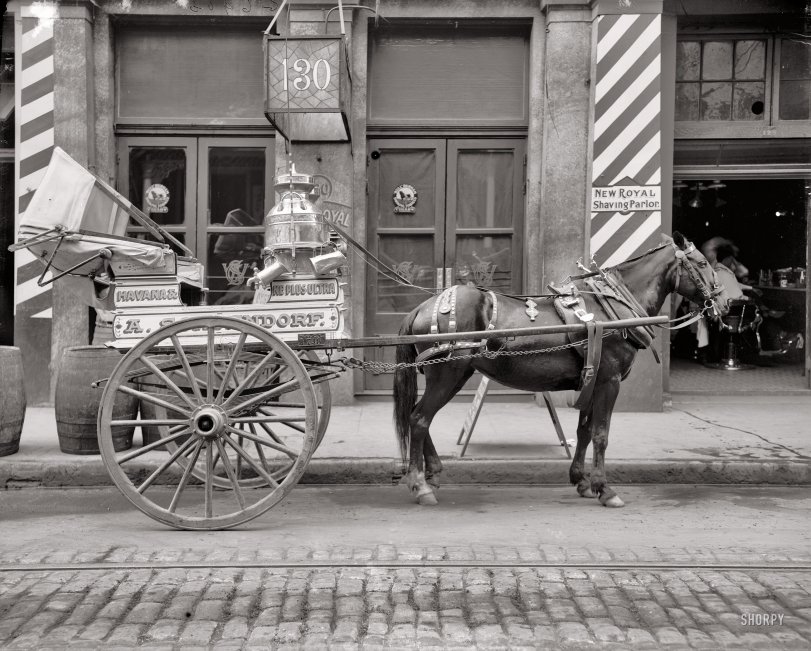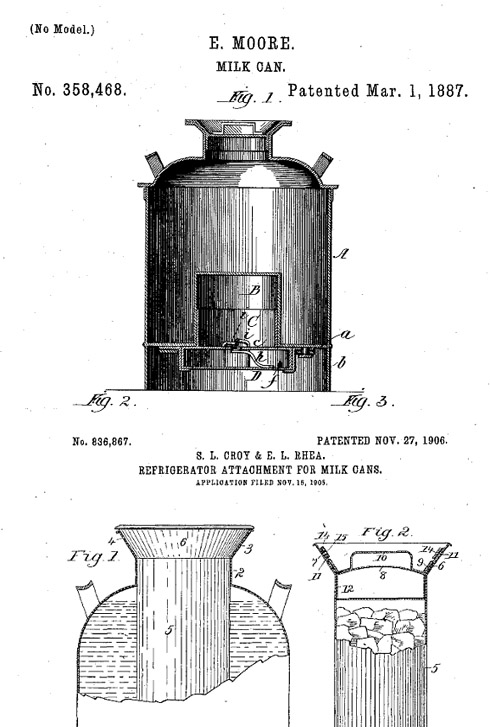


Framed or unframed, desk size to sofa size, printed by us in Arizona and Alabama since 2007. Explore now.
Shorpy is funded by you. Patreon contributors get an ad-free experience.
Learn more.

- Freeze Frame
- Texas Flyer wanted
- Just a Year Too Soon
- WWII -- Replacing men with women at the railroad crossing.
- Yes, Icing
- You kids drive me nuts!
- NOT An Easy Job
- I wonder
- Just add window boxes
- Icing Platform?
- Indiana Harbor Belt abides
- Freezing haze
- Corrections (for those who care)
- C&NW at Nelson
- Fallen Flags
- A dangerous job made worse
- Water Stop
- Passenger trains have right of way over freights?
- Coal
- Never ceases to amaze me.
- Still chuggin' (in model form)
- Great shot
- Westerly Breeze
- For the men, a trapeze
- Tickled
- Sense of loneliness ...
- 2 cents
- Charm City
- What an Outrage
- Brighton Park
Print Emporium
Milk Mare: 1910

New Orleans circa 1910. "A typical milk cart." At the Shaving Parlor. 8x10 inch dry plate glass negative, Detroit Publishing Company. View full size.
Family connection
This was a milk cart that belonged to my great-great-grandfather, Adam Schoendorf. I was delighted to see this, as I had only seen a few photos of it from the back, taken by his daughter Marie. (Those photos were probably lost after Katrina and the levee failure.) Adam Schoendorf owned Hunter's Dairy in New Orleans, located at the corner of Havana and Ne Plus Ultra streets. Ne Plus Ultra is now Lafreniere Street.
A more well-known photo of a different, larger Schoendorf vehicle can be seen here. This wagon is harnessed to a horse named Billy - "the ugliest horse my papa owed, but the smartest" according to Aunt Marie. Billy's harness features medallions with the initials "A.S." The original is in the Library of Congress, and appears in many books about New Orleans.
KV, Adam was not complimenting himself but he could have - he spoke English, German, French, Spanish, and a local patois.
I Approve
The Bull City Boy is all aglow at seeing the Bull Durham (Cigar) ads on the window of the Shaving Parlor's neighbor.
Containers
I think one can barely see the tops of some milk bottles below the drivers seat -- were they optional? Did the driver fill them on the spot?
You may think me too modern
but I like my milk pasteurized, homogenized, ice cold and bought in nice sanitary plastic jugs, thank you very much.
This is 1910
So no, the milk isn't refrigerated, except perhaps at the milk house where this cart driver picks up his can-full every morning.
I used to live where fresh milk could be had every day, and it didn't go bad nearly as fast as the milk does when i buy it at the store in a carton. The farmer we got ours from put aside some milk from his main herd in his walk in cooler in a clean sealed milk can. There it sat for 24 hours, before it was sold. Well, not really sold, but bartered for salmon we would catch from time to time.
It was an excellent arrangement, nobody got sick, he had fresh salmon regularly and we had the best tasting highest quality whole and natural milk I've ever tasted.
[Large milk cans could indeed be refrigerated. Patents for ice-cooled milk cans go back at least to the 1880s. - Dave]

The Ne Plus Ultra of dairy transportation
But, those milk pitchers might be a little too close to the hind end of the mare for me. Does "Havana" and "Ne Plus Ultra" on the side of the wagon indicate that cigars are also sold by the same driver?
Properly Registered
I'm glad to see that this hawker of cow's milk and Havana cigars has a proper New Orleans Cart License (N.O.C.L.) plate. A good shave and a good Cuban cigar are hard to come by in some parts. Milk, not so much.
Ne plus ultra
The Latin self-compliment written onto the wagon is amusing. I don't imagine many milk cartons carry such erudite phrases these days (and the glitzy harness the horse is wearing shows some real panache too).
[Ne Plus Ultra was a cigar street (see above). - Dave]
Horse v. truck
While looking at the harness one needs to put on the horse it is easy to see or imagine why people went to cars and motors.
























On Shorpy:
Today’s Top 5